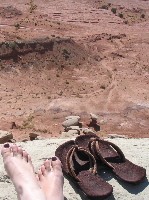AstroVino #2: Sauvignon Blanc & Chenin Blanc
Last night was the second class of the wine appreciation course-like thing I'm taking this fall. We're alternating red and and whites; this week was two of the classic whites: Sauvignon Blanc and Chenin Blanc. Both of these capitalized French names are kinds of grapes. One of the complicated things about wines is the naming conventions: in the Old World (i.e., Europe), wines are named after where they are made (e.g, Bordeaux or Burgandy). This is simply due to the fact that these places have been making wine for a long time, and for a long time, wine could not be transported well. The New World, being newer, takes the simpler route, with wines named after the grapes from which they are made.
We had three Sauvignon Blancs: a 2004 La Reine Blanche Sancerre from the Loire Valley in France, a 2005 Casa Lapostolle from the Rapel Valley in Chile, and a 2005 Villa Maria from the Malborough District in New Zealand. Likewise, we had three Chenin Blancs: a 2005 Vallee de Jardins Vouvray, also from the Loire Valley, a 2005 Bonny Doon Pacific Rim from somewhere in California, and a 2005 Coriole McLaren Vale from South Australia.
Now, I'm a scientist. I like trying to find patterns and using these patterns to try to predict the unknown. Luckily, this is a wine tasting course for scientists: what we may lack in taste differentiation, we try to make up in overanalyzing. The obvious comparison to be made with these wines is to compare and contrast the tastes of the two grapes. The much more interesting one, I find, is to examine how three wines made from genetically identical grapes can taste so drastically different... both climate and technique come into play. I found the difference the most obvious between the first two Sauvignon Blancs: the Loire Valley has a much cooler climate than the Rapel Valley, which is sunny, and this plays out in that the Lapostolle has a sweet, even fruity, taste contrasted against the much more acidic Sancerre. The Lapostolle was my favorite of the evening, actually; it was sweet, to be sure, but not overly so. The McLaren Vale was also fun, as the taste changed over the course of the evening. The real let down was the Bonny Doon Chenin Blanc, which just tasted blah (a Chenin Blank?).
All in all, it was another fun evening. I always enjoy watching how groups self-interact. While the bottles of wine were being passed around and everyone is tasting each for the first time, the room is silent except for the *click* of the precision pour. (Precision pours, incidentally, are incredibly ingenious.) But then all the wines are out, and people start discussing how each tastes, and soon the word "pineapple" is quite amusing. Eventually, more bread and cheese is brought out, people are discussing how long it will be until another ultraviolet sensitive satellite flies and the abundance of animals with different male and female names in English, and the glasses scattered about the table are becoming more and more empty. Good Monday night fun; ten points if you can guess why I'm writing this post on Tuesday.
If anyone knows how to take good notes on how something "tastes," by the way, please let me know. I could actually tell the difference between the wines (and, even, after I got the order of the glasses mixed up, I could identify which glass went with which wine), but when I tried to describe what it tasted like? "Uhm, so this one tastes like white wine, see." Even with all of the component tasting of last week, I'm at a loss of how to describe what I'm tasting.


1 comment:
One time I had Greek wine. It was cheap, but thought, what the hey, I'm having cheese anyway. It tasted like watered-down ouzo. Blech!
Post a Comment